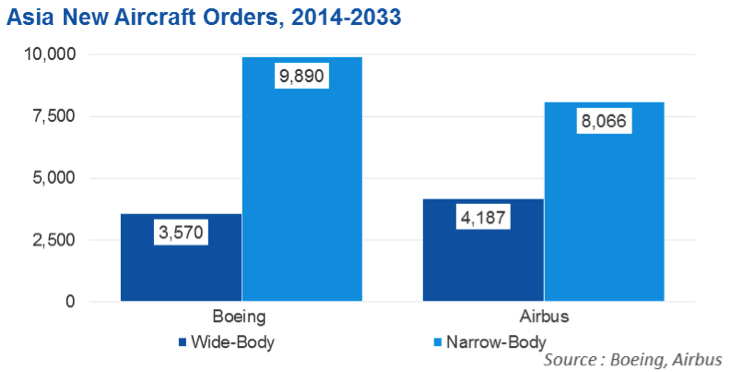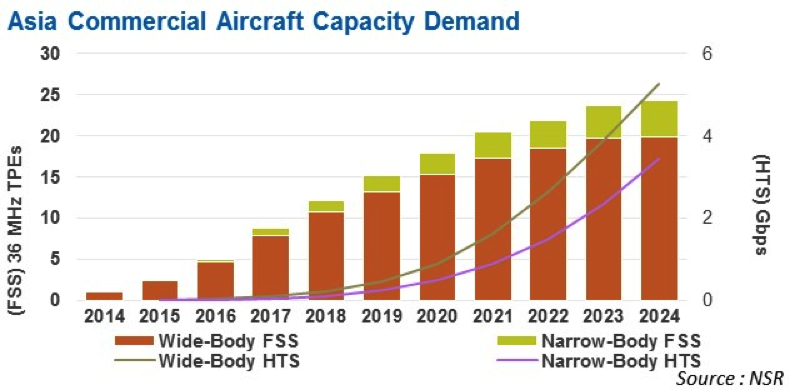IFC in Asia:
A Market for the
Long-Haul
May 18th,
2015
by
Claude
Rousseau,
NSR
Facebook
Tweet
LinkedIn
Email
A few months ago,
both Boeing and
Airbus indicated
they raised their
forecast for new
aircraft deliveries
in large part due to
Asian orders.
It is no secret the
region is set to
become the biggest
market for
commercial passenger
aircraft as GDP
rises. The recent
Panasonic deal to
equip Xiamen
Airlines for its new
fleet of Boeing
B787s with
connectivity may
give a hint as to
what lies ahead for
IFC in Asia: more
in-flight
connectivity demand
for wide-body
airframes.

According to the
ICAO, Asia is
considered to hold
robust growth rates
in passenger traffic
despite the recent
woes of the Chinese
economy, with on
average more than
7.4% passenger
growth on commercial
aircraft in the next
three years.
Both Airbus and
Boeing are looking
much farther into
the future and
forecast approx.
12,800 aircraft will
be purchased by
Asian carriers by
2033, a total close
to 40% of global new
deliveries.
In its recently
released
Aeronautical Satcom
Markets, 3rd
Edition, NSR
forecasts the
Asia
addressable
commercial aircraft
market for satellite
connectivity will
reach more than
11,000 wide-body and
narrow-body planes
by the end of 2024.
This is not only
new aircraft, but it
is clear that by the
end of the next
decade, if only half
of the new
deliveries expected
from Airbus and
Boeing are made
(roughly 6,400 new
planes), it
is a prime market to
outfit with
connectivity right
on the production
line.

But what is more
important is the
majority of the
recent connectivity
deals in the region
(like the Panasonic
deal) have a
strong focus on
wide-body airframes:
China Eastern
Airlines, Garuda
Indonesia, JAL,
Singapore Airlines,
ANA, Cebu Pacific,
Philippine Airlines
are set to outfit
satcom services on
more than 250
wide-bodies, many of
them new aircraft
like the one for
Xiamen. And if we
look at their
connectivity
requirements,
long-haul
flights on wide-body
airframes is where
most of the demand
will originate even
if they represent a
smaller number of
airframes.
According to both
aircraft
manufacturers, the
majority of airline
traffic growth in
Asia is set to take
place inside
China,
which is not
optimal for the
deployment of costly
satellite services
by airlines,
compared to longer
duration flights.
Boeing even stated
in their forecast
that “approximately
65% of growth will
be within China”.
Airbus goes even
farther stating that
“nearly 80% of the
Chinese population
and economy is
within a range of
about 2,000 km”, or
about 2 hours of
flight, notably in
the Eastern part of
the country. As
such, they expect
domestic air travel
will be 60% larger
than the U.S. market
today.
This large growth
in numbers is
certainly enticing
but the flight
durations are not
because over the
same time horizon,
if we look only at
China’s growth in
traffic to Europe,
North America,
Africa and to other
Asian countries, it
is expected to see
on average a 7%
growth. And
this is the driver
for the Asian IFC
market, where the
wide-body is king
and represents
the main
target for
satellite-based
passenger
connectivity.
Bottom
Line
Even if the
volume of
narrow-body aircraft
to be delivered in
Asia in the next 20
years will outnumber
wide-bodies by a
factor of up to 3,
the flight patterns
in the region are
impacting in-flight
connectivity in a
different manner. As
passenger traffic
grows within but
also outside the
region,
satellite-based IFC
in Asia will
primarily grow from
passenger demand on
intercontinental
flights,
those where the main
airframes are
wide-body
aircraft.
And those are in for
the long-haul.